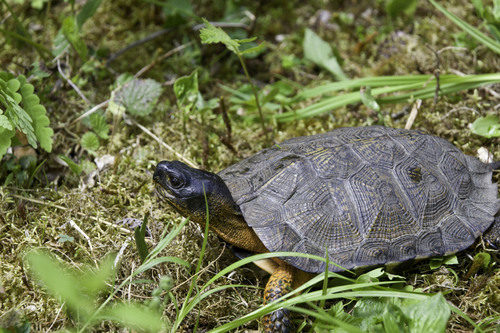
Wood Turtle
The wood turtle (Glyptemys insculpta) boasts a distinctive, rugged shell and thrives in North America's forested streams. Known for its intelligence, this turtle engages in intricate behaviors and seasonal migration, crucially aiding in seed dispersal and maintaining ecological balance.
58 years
Lifespan
1.36078 kg
Weight
Length: 20 - 23 cm
Size
Brown, Yellow, Black, Green, Grey-Brown
Color
14 years
Age of Sexual Maturity
0.2 mph
Top Speed
Endangered
Conservation Status
Decreasing
Population Trend
Characteristics
Glyptemys insculpta, commonly known as the wood turtle, is notable for its rugged, sculptured shell and terrestrial habits. It inhabits deciduous forests and streams in North America. This semi-aquatic turtle is highly intelligent, exhibiting complex behavior patterns and seasonal movements. It plays a vital role in seed dispersal and ecosystem health.
Distribution Range of the Wood Turtle
Glyptemys insculpta, commonly known as the Wood Turtle, is native to North America. Its geographical distribution primarily includes the northeastern United States and southeastern Canada. Specifically, this species is found in the U.S. states of Maine, New Hampshire, Vermont, Massachusetts, Connecticut, New York, New Jersey, Pennsylvania, Maryland, Virginia, and West Virginia. In Canada, it is present in the provinces of Ontario, Quebec, Nova Scotia, and New Brunswick.
Wood Turtle's Habitat
Environmental Conditions
Wood Turtles inhabit areas that offer a mix of aquatic and terrestrial environments. They are typically found along the banks of clear, slow-moving streams and rivers with sandy or muddy substrates. The surrounding terrestrial habitat often includes deciduous or mixed forests, with open meadows or fields nearby. These turtles require areas with ample sunlight for basking, as well as dense vegetation for cover and nesting.
Ecological Niche
Glyptemys insculpta occupies a unique ecological niche, as it is both semi-aquatic and terrestrial. It plays a role in the ecosystem as both a predator and prey. Wood Turtles feed on a variety of foods, including plants, invertebrates, and occasionally small vertebrates, helping control insect populations and contributing to seed dispersal. They are preyed upon by raccoons, foxes, and birds of prey. The species' ability to move between aquatic and terrestrial environments allows it to exploit diverse food resources and habitats, but it also makes it vulnerable to habitat fragmentation and human encroachment.
Copyright @ Nature Style Limited. All Rights Reserved.
 English
English